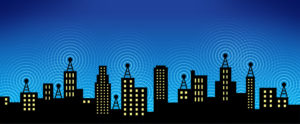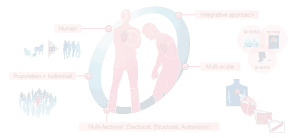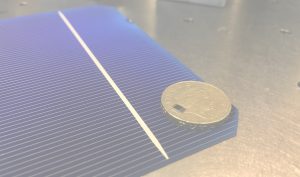If something characterizes us as humans is our communication capabilities, much more advanced than in the rest of species. Language initially served us humans to communicate with precision with our physically close environment, and that limited capability slowly made progress throughout history with revolutionary inventions such as the telegraph or the telephone. James Clerk Maxwell, scientific father of the electromagnetic propagation, would probably not think at his time that his famous equations developed in the 18th century would become the fundamental cornerstone upon which the work of thousands of engineers would be based on a couple of centuries later, who would invent something of such a high societal impact as wireless cellular communications. Because the truth is that talking about wireless communications in the developed world nowadays is, in a certain way, similar to talking about any basic utility such as water or electricity. Or else, who can imagine a professional or personal life without the capability of immediate connection with his or her contacts, or without mobile access to the Internet? It is indeed odd because, despite being difficult to imagine in many situations, being close to this desired ubiquity in communications is a very recent achievement of our society, as the young history of this field demonstrates.
History of wireless cellular communications started only at the beginning of the 80’s with the first generation of cellular technology, “1G”, although the name was given a posteriori as nobody could predict at the time how many generations would follow. It was characterized by using analog communications, where signals were captured, processed, and transmitted completely in the analog domain. This also meant a very inefficient use of the electromagnetic spectrum, and it’s the reason why antennas had to be very large and mobile phones too bulky to generate enough commercial appeal. Everything radically changed with the second generation of cellular technology, or 2G, where the complete digitization of communications allowed i) the widespread growth of the mobile access to the spectrum by distributing its usage among users that would share it in time, ii) sending text for the first time in SMS format, and iii) reducing the size of antennas and mobile phones. Not less important was the reduction of the mobile phone cost, which allowed many of us to acquire a mobile phone for the first time. The next generation, 3G, was also revolutionary as it allowed us to access the Internet for the first time from such a small device as a mobile phone thanks to enhanced techniques of access to the electromagnetic spectrum and a new network architecture. The reachable data rates were however very limited, something 4G has been able to significantly improve changing the medium access technique once again to a something known as OFDMA (Orthogonal Frequency Division Multiple Access), an advanced signal processing technique that allows the avoidance of interference among signals in the frequency domain. Hence, it could be said that we owe OFDMA the capabilities of making a videoconference or watching an online video from our mobile phones.

Five generations of wireless cellular communications
After this introductory journey through past and present generations, we reach the topic that currently keeps both academic and industry researchers extremely busy, including myself: 5G or fifth generation. We are trying to define and develop the next generation of cellular communications, but what is exactly 5G? The reality is that answering this question right now is only ongoing work and depending whom one asks, different definitions can be found. At a commercial level 5G will try to become a communications paradigm that does not only allow very high data rates in our mobile device, enabling new and very demanding applications such as virtual and augmented reality, but also interconnects many other types of objects such as sensors, machines in factories, automobiles, biomedical equipment, etc., thus paving the way for new revolutionary applications such as the autonomous vehicle or remote surgery. At a scientific level, without any doubt the main challenge lies on the scarcity of available spectrum due to the huge amount of wireless technologies and devices that exist nowadays. The solution that is prominently being studied is increasing the frequencies over which the cellular transmission takes place, bringing them to a region of the spectrum where available bands are abundant but which have traditionally been discarded for cellular use due to its terribly hostile characteristics for electromagnetic propagation. Those frequency bands are known as the millimetre wave bands.

Millimetre waves are emitted at frequencies between 30 and 300 GHz, which means a big leap forward compared to the frequencies below 6 GHz over which traditional cellular communications (i.e., until 4G) have been being transmitted. Until now only satellite and radar communications used those frequencies, but they are equipped with a much more specific, bulky and costly hardware than mobile phones. In addition to the attenuation that millimetre waves experience in the free space, proportional to the frequency of the transmission, the biggest challenge lies on the type of environment that we are usually surrounded by since buildings, objects, people, foliage or simply rain gravely attenuate and diffract the waves, making the transmission much less effective. However, a number of possible engineering solutions are already being developed for this scientific challenge, among which we could highlight the utilization of a larger number of coverage regions of smaller size, or the grouping of very large antenna arrays occupying a small physical space, whose dimensions can be greatly reduced thanks precisely to the high frequencies of the transmission.
In conclusion, 5G is being positioned today as a technology that, despite the scientific, technological, and industrial challenges it presents, nobody doubts will reach our lives sooner or later. With that milestone, the dream of achieving truly ubiquitous communications capabilities, anytime and anywhere, will become more real than ever before.
By Dr David M. Gutierrez Estévez, Senior Researcher, Samsung Electronics R&D Institute UK. SRUK London Constituency
More info:
Everything you need to know about 5G – IEEE Spectrum
Wireless: the next generation – The Economist






